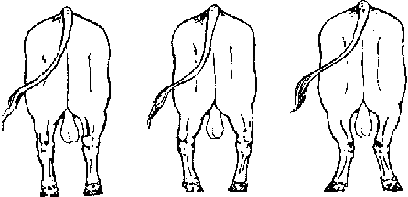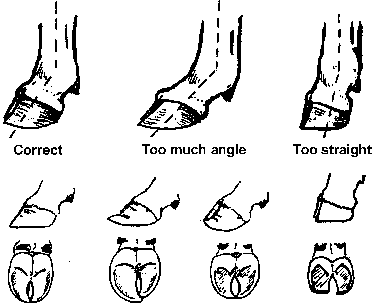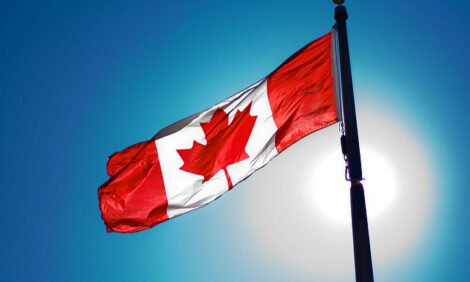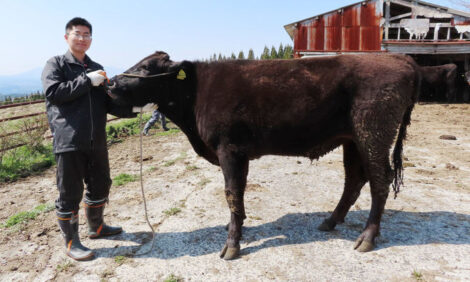



Selecting bulls for structural soundness in beef cattle
By John Bertram et al , Department of Primary Industries and Fisheries.Introduction
The structural soundness of bulls influence the ability of a bull to deliver his genetics to the point of fertilisation (in the cow) for as long as the cattle breeder chooses to use the bull in the herd. Structural soundness embraces a range of traits of the more rigid skeletal structure as well as the softer tissues critical to bull function. We will discuss these under the general headings of Feet and legs, Head and eyes, Sheath and penis.Assessment of bulls
‘Eyeball’, subjective, or visual assessment selection of bulls, is still the most common procedure for many bull buyers. However, this assessment is often done without any clear regard to many functionally important reproductive traits. It is not uncommon for bulls selected with subjective appraisal to have some reproductive and structural abnormalities that are not clearly visible when presented for sale, and may contribute to sub-optimal herd fertility levels.A bull breeding soundness examination is a systematic examination of a bull conducted by a veterinarian and provides opportunity for comment on the animal’s structural soundness. This thorough physical examination can be quick and easy to carry out, and should be a routine procedure pre-sale. A similar procedure can be conducted on property prior to joining and provide evidence for culling unsound bulls.
Functional anatomy of a bull
A bull should be capable of walking long distances, especially in the extensive conditions of north Australia and be able to maintain his body condition. He should have the ability to detect females on heat, and be capable of serving females as they display oestrus. Soundness of limb and skeletal structure contribute to the bull’s longevity and functional effectiveness. Important points of functional anatomy include:Conformation of the legs and hooves
Hind leg conformationExamination of hind leg conformation is an essential phase in evaluating bulls. Sound hind legs are vital to the mating ability of bulls as during mating most of the bull’s weight is supported by the hind legs. The leg should be free of excessive swelling at any of the joints with joint flexure smooth and free of locking in any position. A bull with hind leg defects may suffer pain on moving or mounting which may interfere with its desire to mate. In an ageing bull with faulty conformation, defects become more apparent and may tend to increasing interference with serving ability.
Straight hind legs or ‘post legs’ in the bull predispose the bull to swollen hocks and arthritis in the hip and stifle joints. Sickle hock bulls tend to be clumsy, particularly at service and when dismounting. Each of these conditions can adversely affect a bull’s serving capacity in the longer term. Conversely, a bull will ‘break down’ earlier in life if it has straight legs or sickle hocks as shown in Figure 1.
Figure 1. Hind limb conformation (a) normal, (b) bow legged, (c) cow hocked.

The hooves
Both hooves should be of suitable size to weight bear with the claws of approximately equal size and shape. While defects of the hooves are often associated with poor limb conformation, they may be associated with overfeeding of young bulls, mineral deficiencies, soft soil surface or lack of exercise and confinement in a restricted area.
Figure 2. Pastern angle of front and hind legs and associated claws: (a) correct structure (b) weak in the pastern (c) too straight.

Worn toes are often an indication of the hoof being dragged, which would suggest straight hind legs. Common problems in the hooves include:
The walk
The gait should be well coordinated and smooth with the rear hooves placed in the imprint of the front feet. As a bull moves freely forward, each leg should pass through a plane parallel to the mid-line of the body and not swing in or out as it is carried forward.
Overstepping or understepping may be linked to serving ability of the bulls. Bulls that understep often have straight hind legs and have increased mating problems.
Head and eyes
The upper and lower jaws should be of a similar length (not undershot or overshot) and free of abscesses or swellings. Viruses, animal age, genetic background, UV light and solar activity have been implicated in the development of eye lesions. Bos taurus type cattle have a relatively higher proportion of squamous cell tumours in unpigmented or partially pigmented regions around the eyes. ‘Pop eyes’ protrude from the profile of the head and predispose the bull to cancer eye or injury to the eye. From practical observations, eye cover or hooding with well-set eyes would appear to not only provide greater physical protection, but also ensure decreased glare, ultra violet light and reduced fly related problems.Pelvic opening
A small pelvic opening, which is heritable can predispose the herd to subsequent calving difficulty and may therefore be considered as an important selection trait.Sheath size and shape
Large pendulous sheaths are not uncommon in Bos indicus breeds and will predispose the bull to prolapse and preputial damage. Some bulls have a very thick residue of the umbilicus (navel) which is often associated with a large inverted fold of skin referred to as the ‘rosette’. Both of these conditions appear to limit the bulls’ ability to sire calves.Scrotal circumference and testicular tone
Scrotal circumference is a measure of the daily and total sperm production of a bull. In Bos taurus bulls scrotal circumference should measure 32cm at 2 years of age, whilst Bos indicus bulls in harsh nutritional conditions should measure 28cm at the same age. Testicular tone is an approximate indicator of testicular function. The percentage normal spermatozoa in an ejaculate produced by the testicles is a preferable indicator of the bulls ability to sire calves.June 2005

© The State of Queensland (Department of Primary Industries and Fisheries) 1995 - 2006.
Queensland Government


